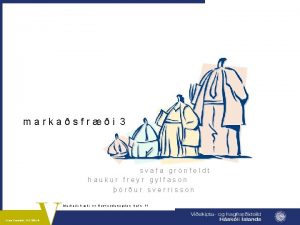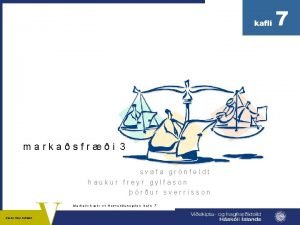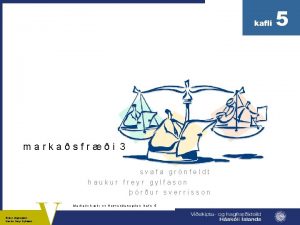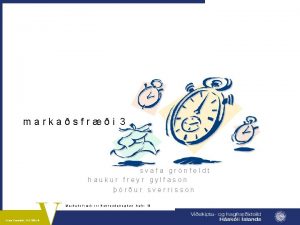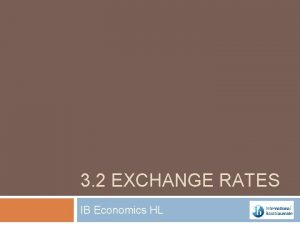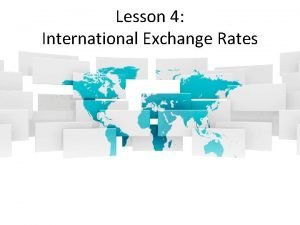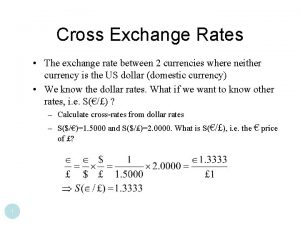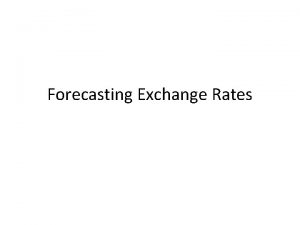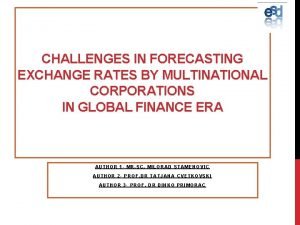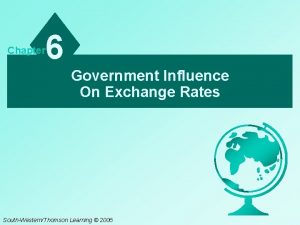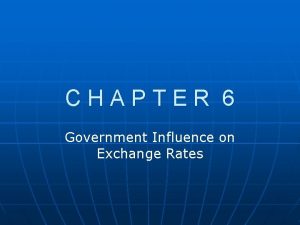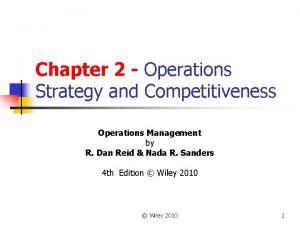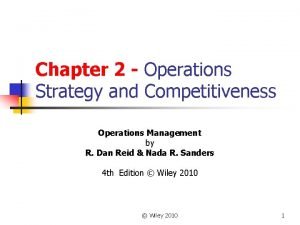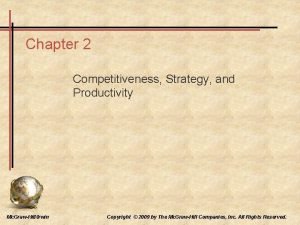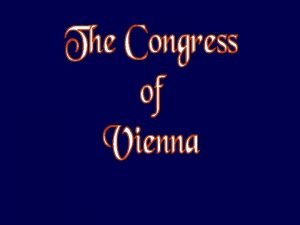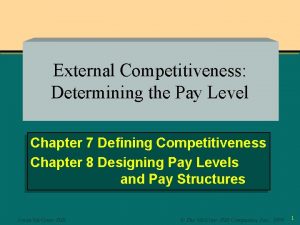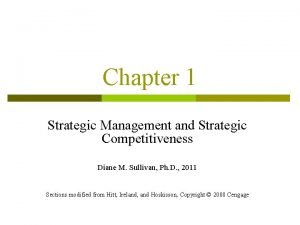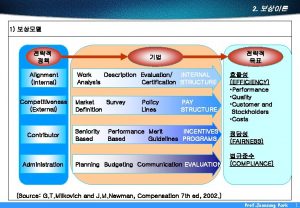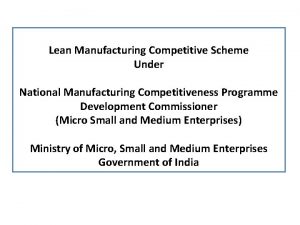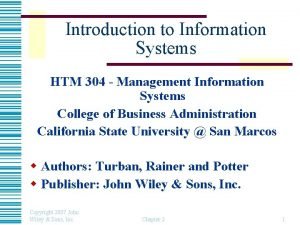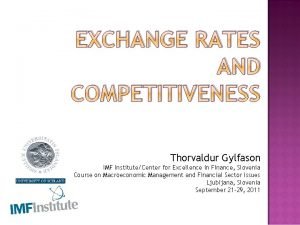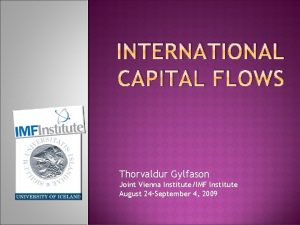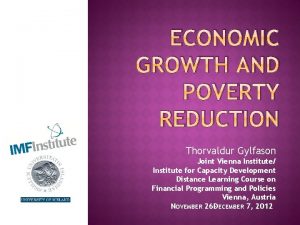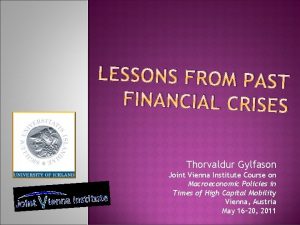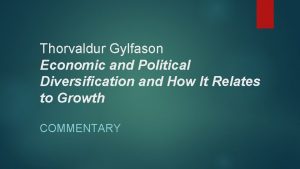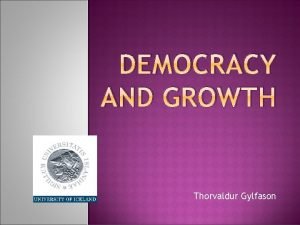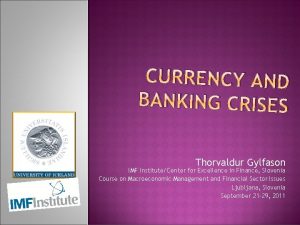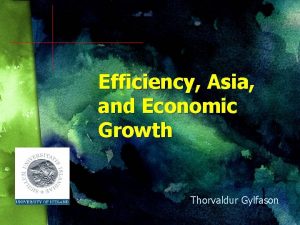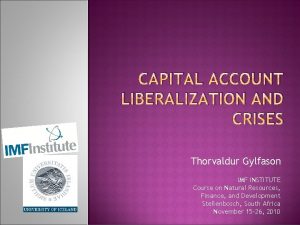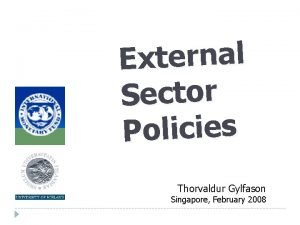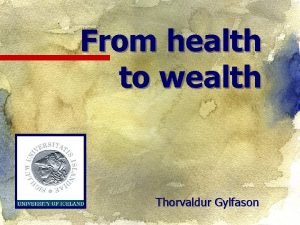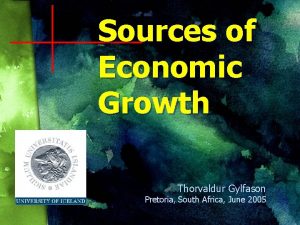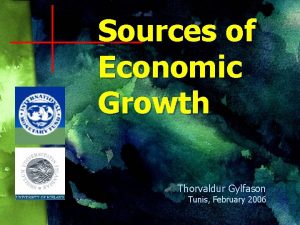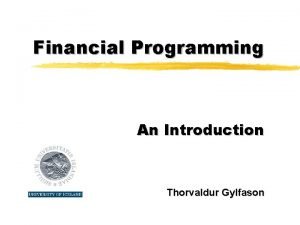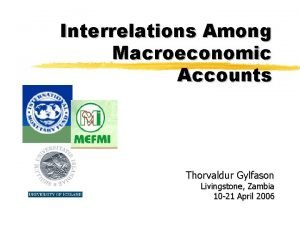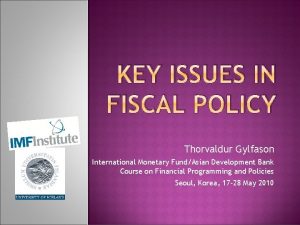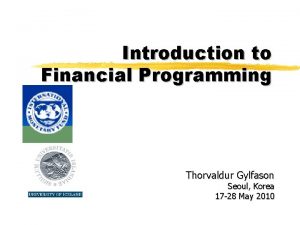EXCHANGE RATES AND COMPETITIVENESS Thorvaldur Gylfason Joint Vienna


















































- Slides: 50

EXCHANGE RATES AND COMPETITIVENESS Thorvaldur Gylfason Joint Vienna Institute Course on Macroeconomic Policies in Times of High Capital Mobility Vienna, Austria May 16– 20, 2011

OUTLINE IN FOUR PARTS 1. Real exchange rates versus nominal exchange rates 2. Exchange rate policy, overvaluation, and welfare 3. Exchange rate regimes ü To float or not to float 4. How many monies do we need?

1 REAL VS. NOMINAL EXCHANGE RATES Increase in Q means real appreciation Q = real exchange rate e = nominal exchange rate P = price level at home P* = price level abroad e refers to foreign currency content of domestic currency

REAL VS. NOMINAL EXCHANGE RATES Devaluation or e depreciation of makes Q also P s s e l n u e t a i c e r p de ve rises so as to lea Q unchanged Q = real exchange rate e = nominal exchange rate P = price level at home P* = price level abroad

THREE THOUGHT EXPERIMENTS 1. Suppose e falls Then more rubles per dollar, so X rises, rises Z falls 2. Suppose P falls Then X rises, rises Z falls 3. Suppose P* rises Then X rises, rises Z falls Capture all three by supposing Q falls Then X rises, rises Z falls

THE IMPORTANCE OF APPROPRIATE SIDE MEASURES Remember: Devaluation needs to be accompanied by fiscal and monetary restraint to prevent prices from rising and thus eating up the benefits of devaluation To work, nominal devaluation must result in real devaluation

Real exchange rate 2 EXCHANGE RATE POLICY AND WELFARE yments for imports of Pa s, and e ic v r e s , s d o go capital Imports Equilibrium ts of r o p x e m ro Earnings f , and s e c i v r e s goods, capital Exports Foreign exchange

EXCHANGE RATE POLICY AND WELFARE Equilibrium between demand supply in foreign exchange market establishes üEquilibrium real exchange rate üEquilibrium in balance of payments BOP = X + Fx – Z – Fz =X–Z+F = current account + capital account = 0 ccount a t n e r r u c = Z – X ccount a l ia c n a in f d n a F = capital

EXCHANGE RATE POLICY R moves when AND WELFARE R Real exchange rate e is fixed Deficit Imports Overvaluation Exports Foreign exchange

Price of foreign exchange EXCHANGE RATE POLICY AND WELFARE Overvaluation works like a price ceiling Supply (exports) Overvaluation Deficit Demand (imports) Foreign exchange

APPLICATION 1: DUTCH DISEASE Appreciation of currency in real terms, either through inflation or nominal appreciation, leads to a loss of export competitiveness In 1960 s, Netherlands discovered natural resources (gas deposits) Currency appreciated Exports of manufactures and services suffered, but not for long Not unlike natural resource discoveries, aid inflows could trigger the Dutch disease in New Palgrave in ” e s a e receiving countries is D h tc See my “Du s Online ic m o n o c E f o y r a Diction

Real exchange rate DUTCH DISEASE: HOW OIL EXPORTS CROWD OUT NONOIL EXPORTS C B A Oil discovery leads to appreciation, and reduces nonoil exports Imports Exports with oil Exports without oil Foreign exchange Composition of exports matters

DUTCH DISEASE: HOW FOREIGN AID CAN CROWD OUT EXPORTS rade vs. aid Real exchange rate T C B A Foreign aid leads to appreciation, and reduces exports (e. g. , Zambia) Imports Exports with aid Exports without aid Foreign exchange

APPLICATION 2: OVERVALUATION Governments may try to keep the national currency overvalued üTo keep foreign exchange cheap üTo have power to ration scarce foreign exchange üTo make GNP look larger than it is Other examples of price ceilings üNegative real interest rates üRent controls in cities

INFLATION AND OVERVALUATION Inflation can result in an overvaluation of the national currency üRemember: Q = e. P/P* Suppose e adjusts to P with a lag Then Q is directly proportional to inflation Numerical example

INFLATION AND OVERVALUATION Real exchange rate Suppose inflation is 10 percent per year 110 105 100 Average Time

INFLATION AND OVERVALUATION Real exchange rate Suppose inflation rises to 20 percent per year d Hence, increase real inflation lifts the s long a e t a r e g n a h c x e as the nominal exchange rate g adjusts with a la 120 110 Average 100 Time

HOW TO CORRECT OVERVALUATION Under floating Depreciation is automatic: e moves But depreciation may take time Under a fixed exchange rate regime Devaluation will lower e and thereby also Q – provided inflation is kept under control Does devaluation improve the current account? The Marshall-Lerner condition

MARSHALL-LERNER CONDITION: THEORY B = e. X – Z = e. X(e) – Z(e) Valuation effect arises from the ability to affect foreign prices Lower e raises X Z Lower e reduces ed, Suppose prices are fix so that e = Q Not clear that a lower e helps B because decrease in e lowers e. X if X stays put Let’s do the arithmetic Bottom line is: Devaluation strengthens current account as long as s a = elasticity of export s b = elasticity of import

MARSHALL-LERNER CONDITION -a Export elasticity 1 Lower e raises X Z Lower e reduces - + Import b elasticity 1

MARSHALL-LERNER CONDITION b -a X y Assume X = Z/e initiall if unt o c c a t n e r r u c s n ake Appreciation we

MARSHALL-LERNER CONDITION: EVIDENCE Econometric studies indicate that the Marshall-Lerner condition is almost invariably satisfied Industrial countries: a = 1, b = 1 Developing countries: a = 1, b = 1. 5 Hence, s n e h t g n e r t s n io t a lu a v De the current account

EVIDENCE FROM DEVELOPING COUNTRIES Argentina Brazil India Kenya Korea Morocco Pakistan Philippines Turkey Average Elasticity of exports 0. 6 0. 4 0. 5 1. 0 2. 5 0. 7 1. 8 0. 9 1. 4 1. 1 Elasticity of imports 0. 9 1. 7 2. 2 0. 8 1. 0 0. 8 2. 7 1. 5

THE SMALL COUNTRY CASE Small countries are price takers abroad ü Devaluation has no effect on the foreign currency price of exports and imports So, the valuation effect does not arise Devaluation will, at worst, if exports and imports are insensitive to exchange rates (a = b = 0), leave the current account unchanged Hence, if a > 0 or b > 0, devaluation strengthens the current account

RECENT IMF STUDY (2006) For an emerging country with … üInitial trade balance üExport-to-GDP ratio of 40% … nominal depreciation by 10% permanently improves trade balance by 1½% to 2% of GDP in medium term üEffect depends on class of exporter üOil, non-oil, manufactures üMost of the effect is through imports and is felt within 3 to 5 years

3 EXCHANGE RATE REGIMES The real exchange rate always floats üThrough nominal exchange rate adjustment or price change Even so, it matters how countries set their nominal exchange rates because floating takes time There is a wide spectrum of options, from absolutely fixed to completely flexible exchange rates

EXCHANGE RATE REGIMES There is a range of options Monetary union or dollarization üMeans giving up your national currency or sharing it with others (e. g. , EMU, CFA, EAC) Currency board üLegal commitment to exchange domestic foreign currency at a fixed rate Fixed exchange rate (peg) Crawling peg Managed floating Pure floating

EXCHANGE RATE REGIMES Currency union or dollarization Currency board Peg FIXED Fixed Horizontal bands Crawling peg Without bands With bands Floating FLEXIBLE Managed Independent

BASICALLY FIXED Dollarization Use another country’s currency as sole legal tender Currency union Share same currency with other union members Currency board Legally commit to exchange domestic currency for specified foreign currency at fixed rate Conventional (fixed) peg Single currency peg Currency basket peg

INTERMEDIATE Flexible peg Fixed but readily adjusted Crawling peg Complete §Compensate for past inflation §Allow for future inflation Partial §Aimed at reducing inflation, but real appreciation results because of the lagged adjustment Fixed but adjustable

BASICALLY FLOATING Managed floating Management by sterilized intervention I. e. , by buying and selling foreign exchange Management by interest rate policy, i. e. , monetary policy E. g. , by using high interest rates to attract capital inflows and thus lift the exchange rate of the currency Pure floating

IMPOSSIBLE TRINITY FREE CAPITAL MOVEMENTS ly n o e s o o h Free to c ns; o i t p o e e r two of th of e n o e c i f i must sacr the three 2 Monetary Union (EU) 1 FIXED EXCHANGE RATE 3 MONETARY INDEPENDENCE

IMPOSSIBLE TRINITY FREE CAPITAL MOVEMENTS ly n o e s o o h Free to c ns; o i t p o e e r two of th of e n o e c i f i must sacr the three 2 1 FIXED EXCHANGE RATE 3 Capital controls (China) MONETARY INDEPENDENCE

IMPOSSIBLE TRINITY FREE CAPITAL MOVEMENTS ly n o e s o o h Free to c ns; o i t p o e e r two of th of e n o e c i f i must sacr the three 2 Flexible exchange rate (US, UK, Japan) 1 FIXED EXCHANGE RATE 3 MONETARY INDEPENDENCE

IMPOSSIBLE TRINITY FREE CAPITAL MOVEMENTS ly n o e s o o h Free to c ns; o i t p o e e r two of th of e n o e c i f i must sacr the three 2 Flexible exchange rate (US, UK, Japan) Monetary Union (EU) 1 FIXED EXCHANGE RATE 3 Capital controls (China) MONETARY INDEPENDENCE

FIX OR FLEX? If capital controls are ruled out in view of the proven benefits of free trade in goods, services, labor, and also capital (four freedoms), freedoms … … then long-run choice boils down to one between monetary independence (i. e. , flexible exchange rates) vs. fixed rates Cannot have both! Either type of regime has advantages as well as disadvantages Let’s quickly review main benefits and costs

BENEFITS AND COSTS Benefits Fixed exchange rates Floating exchange rates Costs

BENEFITS AND COSTS Benefits Fixed exchange rates Floating exchange rates Stability of trade and investment Low inflation Costs

BENEFITS AND COSTS Fixed exchange rates Floating exchange rates Benefits Costs Stability of trade and investment Low inflation Inefficiency BOP deficits Sacrifice of monetary independence

BENEFITS AND COSTS Benefits Costs Fixed exchange rates Stability of trade and investment Low inflation Inefficiency BOP deficits Sacrifice of monetary independence Floating exchange rates Efficiency BOP equilibrium

BENEFITS AND COSTS Benefits Fixed exchange rates Floating exchange rates Stability of trade and investment Low inflation Costs Inefficiency BOP deficits Sacrifice of monetary independence Efficiency Instability of BOP equilibrium trade and investment Inflation

BENEFITS AND COSTS To eliminate high inflation, need fixed me exchange rate for a ti In view of benefits and costs, no single exchange rate regime is right for all countries at all times The regime of choice depends on time and circumstance § If inefficiency and slow growth due to currency overvaluation are the main problem, floating rates can help § If high inflation is the main problem, fixed exchange rates can help, at the risk of renewed overvaluation § Ones both problems are under control, time may be ripe for monetary union What do countries do?

What countries actually do (Number of countries, April 2008) (22) (84) (12) (44) (40) (76) (10) (66) (3) (5) (2) Source: Annual Report on Exchange Arrangements and Exchange Restrictions database. 46

WHAT COUNTRIES ACTUALLY DO (2008, 182 COUNTRIES) No national currency Currency board Conventional fixed rates Intermediate pegs Managed floating Pure floating 6% 7% 36% 5% 24% 22% 100% 54% 46% There is a gradual tendency towards floating, from 10% of LDCs in 1975 to almost 50% today, followed by increased interest in fixed rates through economic and monetary unions

WHY WE HAVE FEWER CURRENCIES THAN COUNTRIES In view of the success of the EU and the euro, economic and monetary unions appeal to many other countries with increasing force Consider four categories Existing monetary unions De facto monetary unions Planned monetary unions Previous – failed! – monetary unions 4

EXISTING MONETARY UNIONS CFA franc 14 CFP franc 3 Pacific island states East Caribbean dollar 8 African countries Caribbean island states Picture of Sir W. Arthur Lewis, the great Nobel-prize winning development economist, adorns the $100 note Euro, more recent 16 EU countries plus 6 or 7 others Thus far, clearly, a major success in view of old conflicts among European nation states, cultural variety, many different languages, etc.

DE FACTO MONETARY UNIONS Australian dollar Australia Indian rupee India plus Bhutan (plus Nepal) New Zealand dollar New plus 3 Pacific island states Zealand plus 4 Pacific island states South African rand South Africa plus Lesotho, Namibia, Swaziland – and now Zimbabwe Swiss franc Switzerland plus Liechtenstein US dollar US plus Ecuador, El Salvador, Panama, and 6 others

PLANNED MONETARY UNIONS East African shilling (2009) Burundi, Kenya, Rwanda, Tanzania, and Uganda Eco (2009) Gambia, Ghana, Guinea, Nigeria, and Sierra Leone (plus, perhaps, Liberia) Khaleeji (2010) Bahrain, Kuwait, Qatar, Saudi-Arabia, and United Arab Emirates Other, more distant plans Caribbean, Southern Africa, South Asia, South America, Eastern and Southern Africa, Africa

PREVIOUS MONETARY UNIONS 99. 95% Danish krone 1886 -1939 Denmark and Iceland 1886 -1939: 1 IKR = 1 DKR 2009: 2, 500 IKR = 1 DKR (due to inflation in Iceland) Scandinavian monetary union 1873 -1914 Denmark, East African shilling 1921 -69 Kenya, Tanzania, Uganda, and 3 others Mauritius rupee Mauritius and Seychelles 1870 -1914 Southern African rand South Norway, and Sweden Africa and Botswana 1966 -76 Many others nt a c i f i n g i s No ces i r p f o e c divergen es t a r y c n e r or cur ion t a r a p e s following

CONFLICTING FORCES Centripetal tendency to join monetary unions, thus reducing number of currencies To benefit from stable exchange rates at the expense of monetary independence Centrifugal tendency to leave monetary unions, thus increasing number of currencies To benefit from monetary independence often, but not always, at the expense of exchange rate stability With globalization, centripetal tendencies appear stronger than centrifugal ones d n E e Th
 Ratios rates and unit rates
Ratios rates and unit rates Ratios rates and unit rates guided notes
Ratios rates and unit rates guided notes Ratios rates and unit rates
Ratios rates and unit rates Ratios rates and unit rates
Ratios rates and unit rates Haukur freyr gylfason
Haukur freyr gylfason Haukur freyr gylfason
Haukur freyr gylfason Haukur freyr gylfason
Haukur freyr gylfason Frumhrif
Frumhrif Haukur freyr gylfason
Haukur freyr gylfason Exchange rates grade 11 maths literacy
Exchange rates grade 11 maths literacy Exchange rates worksheet
Exchange rates worksheet Exchange rate diagram ib economics
Exchange rate diagram ib economics Exchange rates lesson
Exchange rates lesson Cross rate
Cross rate The main approaches to forecasting exchange rates are
The main approaches to forecasting exchange rates are Challenges in forecasting exchange rates
Challenges in forecasting exchange rates Market-based forecasting of exchange rates
Market-based forecasting of exchange rates Market based forecasting of exchange rates
Market based forecasting of exchange rates Government influence on exchange rates
Government influence on exchange rates Graphing exchange rates
Graphing exchange rates Government intervention in exchange rates
Government intervention in exchange rates Semi permanent joint
Semi permanent joint Ellipsoid joint examples
Ellipsoid joint examples Chapter 2 operations strategy and competitiveness
Chapter 2 operations strategy and competitiveness Competitive operations strategy
Competitive operations strategy Quality-based strategy examples
Quality-based strategy examples Scale based strategy
Scale based strategy Productivity and competitiveness in operations management
Productivity and competitiveness in operations management Operations strategy and competitiveness
Operations strategy and competitiveness Competitiveness strategy and productivity
Competitiveness strategy and productivity Chapter 2 competitiveness strategy and productivity
Chapter 2 competitiveness strategy and productivity Resource based model
Resource based model Competitiveness strategy and productivity
Competitiveness strategy and productivity Determination of exchange rate
Determination of exchange rate Voluntary exchange
Voluntary exchange Gas exchange key events in gas exchange
Gas exchange key events in gas exchange Congress of vienna map before and after
Congress of vienna map before and after Spool joint lamb
Spool joint lamb What type of joint is the intervertebral joint
What type of joint is the intervertebral joint Joint venture journal entries
Joint venture journal entries Break joint vs spool joint
Break joint vs spool joint External competitiveness
External competitiveness What is strategic competitiveness
What is strategic competitiveness Pay mix policy alternatives
Pay mix policy alternatives Apec services competitiveness roadmap
Apec services competitiveness roadmap National manufacturing competitiveness programme
National manufacturing competitiveness programme Internal competitiveness
Internal competitiveness Technological competitiveness
Technological competitiveness Lean manufacturing competitiveness scheme
Lean manufacturing competitiveness scheme The best-known framework for analyzing competitiveness is
The best-known framework for analyzing competitiveness is Strategic competitiveness
Strategic competitiveness




